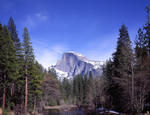Yosemite National Park News Release
July 6, 2006
For Immediate Release
Yosemite National Park Officials Expect an Increase in Douglas-Fir Tussock Moth Caterpillars this Summer
Visitors to Yosemite National Park should be prepared for increased numbers of Douglas-fir tussock moth caterpillars from July through September of this year.
The Douglas-fir tussock moth is a native insect that is found in middle elevation fir forests near the Crane Flat and Chinquapin areas. Records indicate that every few decades, moth populations erupt and consume the needles of white fir trees. During an irruption, the caterpillars may kill trees over an extensive area.
Douglas-fir tussock moth populations typically show rapid decline and massive die-off from predation, food supply depletion, and a naturally-occurring virus.
Yosemite officials are advising visitors of possible human health effects caused by contact with the Douglas-fir tussock moth. The hairs on the caterpillars, egg masses and cocoons may cause allergic reactions. Adverse health effects can include skin irritation, rashes, watery eyes, runny nose, coughing and respiratory distress.
People are advised in taking preventative measures such as avoiding exposure to infested areas, not handling caterpillars, wearing broad-brimmed hats and long sleeved shirts, changing into clean clothes and frequently washing exposed skin with fresh water.
The moths play a natural role in regulating white fir tree densities. Natural cycles such as this are one of the forces that have and will continue to change the landscape in this park. Park managers will continue to monitor and assess the moth population throughout the summer. Visitors are encouraged to call +1 209 372-0200 for additional information.
-NPS-
Douglas Fir Tussock Moth Caterpillars
All posts are those of the individual authors and the owner
of this site does not endorse them. Content should be considered opinion
and not fact until verified independently.
Sorry, only registered users may post in this forum.


